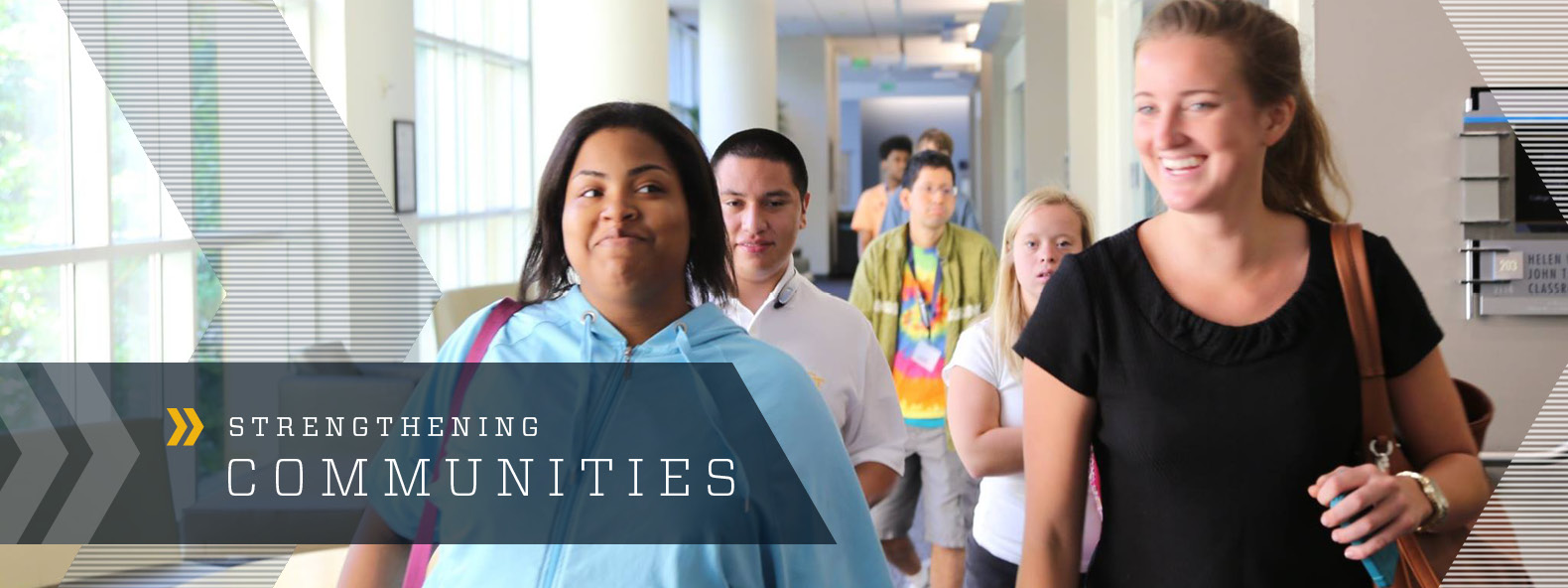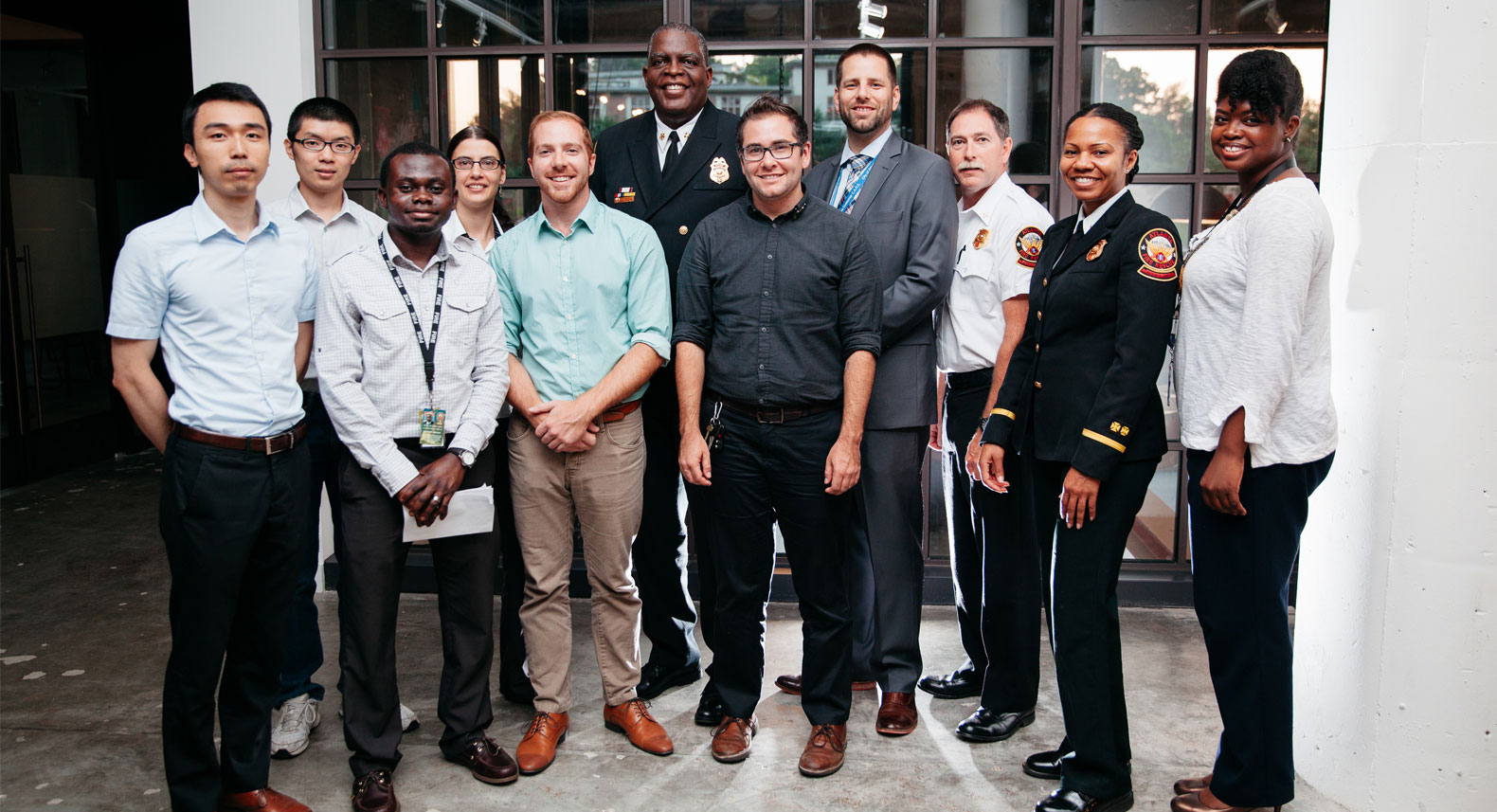
Annual Report Navigation
Strengthening Communities
Georgia Tech students and faculty are renowned for developing innovative research and education initiatives that have a profound impact on communities. These impacts can be felt as far away as the other side of the globe or as close as our own backyard.
Community-Focused Research
Tech Partners with Atlanta and Georgia State in MetroLab Network
Georgia Tech, the City of Atlanta, and Georgia State University are founding members of the MetroLab Network. The goal of the forum is to research, develop, and deploy new technologies to address challenges in the nation’s urban areas.
The MetroLab Network will provide members with the opportunity to share successes, address challenges, and build shared platforms for experimentation and data between cities and universities necessary to increase the tangible results of new innovations.
“The City of Atlanta is proud to participate in the MetroLab Network.”
Mayor Kasim Reed
The MetroLab Network is based on previous successes of technologies developed from established city/university partnerships. These partnerships have produced innovative transportation and water infrastructure projects that have increased the efficiency and reduced the environmental impact of infrastructure systems.
“The City of Atlanta is proud to participate in the MetroLab Network,” said Mayor Kasim Reed. “We look forward to leveraging this opportunity to take advantage of our strong university talent base and their extensive experience in technology, engineering, and computer science to develop innovative solutions to some of our most pressing infrastructure and service challenges.”
“As an urban research university, Georgia State is deeply entrenched in Atlanta’s success and in the success of cities around the world,” said Georgia State President Mark Becker. “We welcome the opportunity to work closely with the City of Atlanta and Georgia Tech to find creative solutions to critical societal issues.”
People-powered Photo Station Lands at Atlanta Airport
Travelers making their way through the atrium and selected concourses at Hartsfield-Jackson Atlanta International Airport were able to take a picture in a photo station powered by human motion.
The technical mechanism, called piezoelectricity, couples mechanical stress or vibrations to electrical energy (electricity). This clean, renewable energy-generation method is being developed for applications such as harnessing vehicle vibrations under roadways, foot traffic underneath walkways, and other wasted daily human movements.

Project participants include the Georgia Tech Research Institute (GTRI), College of Design, Woodruff School of Mechanical Engineering, high school students from B.E.S.T. Academy, and representatives from the Georgia Center of Innovation for Energy Technology, Hartsfield-Jackson Atlanta International Airport, Interface, and OMG Booth. (Photo by Steven Thomas/Georgia Tech Research Institute.)
The interactive system, dubbed People-Powered Photo Station, is the creation of a team of researchers from the Georgia Tech Research Institute (GTRI), the College of Design, and the Woodruff School of Mechanical Engineering, along with high school interns participating in Tech’s Project ENGAGES (Engaging New Generations at Georgia Tech through Engineering and Science).
The photo station uses piezoelectric (PZ) material to generate energy. The PZ material is embedded in carpet tiles that form the system’s floor, which is coupled to its camera. Attached is a series of 8-foot-tall acrylic cylinders that contain multicolored, programmable LED lights. The lights are programmed to respond to movement on the PZ carpet tiles. Once the tiles are activated, the cylinders will illuminate. The illumination will increase until enough light is available to take a photo, which can then be instantly shared on social media via the station’s tablet interface.
“We were approached by Liza Milagro, senior sustainability planner at the airport, and asked if we could utilize our developing technology to demonstrate the potential of harvesting energy through biomechanical motion in an approachable and entertaining method,” said Ilan Stern, project director and GTRI research scientist. “We saw this as a great opportunity to share with the public some of the applications of this underutilized energy-harvesting method.”
Educational Outreach/Opportunity
‘Excel’ Creates Unique College Opportunities
For many high school students, graduation usually leads to the possibility of college or other continued education at more than 7,000 colleges across the country. Students with intellectual and developmental disabilities, though, have a little more than 200 choices in comparison to their peers.
This year, Georgia Tech began offering a postsecondary academy for high school graduates with mild intellectual and developmental disabilities. The program, Excel, provides these students with a learning experience through which they can build on their education, life skills, and independence. Students who participate in the four-year program earn two certificates: one in social growth and academic enrichment, and a second that also incorporates career exploration.
“We’re creating college opportunities for students who have historically been shut out of the college experience, and it’s a game changer because we are doing it at Georgia Tech, one of the top 10-ranked public universities,” said Ken Surdin, director of Excel.
Around 2,000 students in Georgia high schools are eligible for this kind of program, but until Excel, there was only one program in the state, offering 15 spots a year. Excel has eight students this year and expects to enroll around 12 additional students per year, with a peak enrollment of around 48 students. The Excel curriculum includes traditional subjects such as reading comprehension, mathematics, and science, as well as life skills such as financial literacy, interpersonal communication, and community engagement.
“Tech prides itself on being innovative and coming up with the next great thing,” said Marnie Williams, peer support program coordinator for Excel. “People with disabilities have been left out of a lot of those conversations, but they have a lot to contribute.”
Students Use Data Science to Solve Society’s Problems
Fires will happen. But what if the Atlanta Fire Rescue Department could determine which buildings are at greatest risk of fire and prioritize inspections to focus on those sites?

The Data Science for Social Good team presented their work to an audience of local data scientists, as well as firefighters, at the final summer presentation at General Assembly.
The fire department worked to do just that thanks to a summer internship program sponsored by Georgia Tech and Oracle. The city agency is one of four groups that participated in last year’s Data Science for Social Good (DSSG), where 14 undergraduate and graduate students showed nonprofits and government agencies how data can tackle societal problems.
“It’s important to get students involved in real-world projects,” said Christopher LeDantec, co-director of the program and an assistant professor of digital media in the School of Literature, Media, and Communication in the Ivan Allen College of Liberal Arts. “We are building out sustainable learning opportunities that allow students and Georgia Tech to have a wider impact in the community.”
The four students who worked with Atlanta Fire Rescue shadowed inspectors to learn not only how they work, but also how they create and use data. The students identified hundreds of additional commercial properties at high risk for fire that should be inspected with greater frequency.
While many public agencies and nonprofits collect data, staff may be overwhelmed by the volume or may lack the time and capabilities to interpret the information, said Bistra Dilkina, co-director of the DSSG program and an assistant professor in the School of Computational Science and Engineering in the College of Computing. The program shows groups how data can work to their advantage while exposing students to different career paths, Dilkina said.
Campus Improvements
Central Campus Landscaping, Infrastructure
TECH GREEN: The popular green space adjacent to Clough Commons was closed last winter for improvements to enhance the area’s soil and drainage system. System upgrades will help the field recover more quickly after heavy rains and intense use, ultimately resulting in more usable green space.
CHERRY STREET: A recent project refreshed vegetation, replaced materials, and restored quality to the landscaping and hard surfaces in the area to the west of Tech Tower. The Corliss pump that many are fond of photographing has a refreshed surrounding space that includes tables and chairs, benches, and bike racks.
ATLANTIC DRIVE: A significant section of steam pipes originally installed in the 1950s was replaced along Atlantic Drive. The pipes support several surrounding buildings and their heating and research needs. The project also improved the landscape and hardscape in the area to create a more pedestrian-friendly avenue in the middle of campus.
Bicycle Master Plan Finalized
Four years ago, Georgia Tech was lauded by the League of American Cyclists as a silver-level Bicycle Friendly University — the only school on the East Coast to make the list. Since then, the Institute hasn’t just been coasting. Many infrastructure improvements have been made, including new bike lanes, additional racks, and even free, quick repair stations.
Now, a long-term next step has been completed with the finalization of Tech’s first Bicycle Master Plan. The plan will serve as a reference and guide to inform all campus projects going forward.
“The plan provides guidance, but it’s not prescriptive,” said Jason Gregory, senior educational facilities planner in Capital Planning and Space Management.
The Bicycle Master Plan began as an idea from Tech’s Bicycle Infrastructure Improvement Committee (BIIC), a group that includes students, faculty, and staff who work to make Tech a more bike-friendly place. When students brought the idea to Capital Planning and Space Management, they were happy to partner in the process.
Five key actions were determined during the planning process: make biking more visible on campus, improve access to campus, develop and support bike culture, establish dedicated funding, and identify and clarify partner roles.
What's next? ![]() Focusing on the Power of Philanthropy
Focusing on the Power of Philanthropy
Annual Report Navigation
(text and background only visible when logged in)
